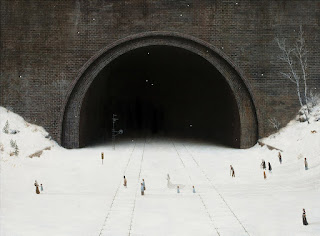The Art of Aron Wiesenfeld
August 24, 2021
The Art of Aron Wiesenfeld
I have been following the art of Aron Wiesenfeld only since last year. Apparently, he was Marvel Comics' star artist-in-rise during the late nineties. At that time, I was only a ten-year-old kid living in a semi-rural neighbourhood of the Indian state of west Bengal. As far as I remember, my family got hold of a colour television in the late nineties and the cable connection came couple of years later. In the later part of the first decade of the new millennium, I came to know about Marvel Comics; but Aron, by then, have left the comic-book world and got engaged in more serious art with mostly oil and charcoal. Being ignorant of the presence of Aron in the world, the wheels of my life kept on turning. After a couple of years, I shifted to Kolkata, started my graduation in literature from an Institution in the heart of the old city. College street, the biggest book treasure-hunt in India, was our campus per se. In college street, while surfing the collections of street vendors in the flea market of second-hand books, I discovered an old one on the paintings of an American painter named James Whistler. The book was hidden underneath a pile of art books and magazines, only the grey opaque face of an old woman was peeping. I remember how I kept on staring at the image under the scorching sun of mid-July, and suddenly time was slowed down, the busy midday traffic passed by like generations passes from the age of the earth. The relatively leaden painting was absorbing my reality like a sponge: the more my sense of belonging to my time was drying up, the more the painting was getting heavier with sentiency. I bought that book with my little pocket money, and kept it under my pillow like a totem that'll save me from reality in my sleepless nights.
This was the time when Aron was painting 'Ruth', which will show up in my Instagram feed after twelve years, on a sleepless silent night of two thousand twenty, in the midst of the year-long lock-down due to the most devastating (un)natural calamity of our time; and I will feel the same shivering of a certain unbelonging that I felt a decade back while having a look at Whistler's Mother. That night I found Aron Wiesenfeld, when his art is already being recognised throughout the world. However, in my time(line) and space, it was not quite late. I know, there will be time to prepare myself to meet the faces that I am destined to meet.
Now, 'finding' is an interesting verb to use in
reference to Aron's paintings. We 'discover' something which is New, we 'find'
something which was lost. As I have mentioned earlier, Aron's paintings give me
a sense of 'unbelonging' because, they somehow simulate a memory where I was a
part of those frames in a forgotten time. Most of his paintings, as
others have noticed, tries to capture a lost person, usually a waif-like thin
young girl or an adolescent boy, forsaken by the world of human beings but sheltered
by the world itself. In clearer words: his paintings depict a young human
subject who is not an object to anyone or anything in the painting. Aron’s
characters are alone, sad and melancholic young selves who were promised to
someone, or who bore the possibility of becoming a part of someone's promise,
but at some point, lost their way back to the premise of promises which
eventually shape our Society. As Aron himself explains: the paintings are about
that moment of uncertainty, in which all possibilities are still open. But the
question is, are they?
Aron's painting reflects the nostalgic melancholy
of the paintings of Casper David Friedrich, Pierre de Chavannes’ toned-down
human symbolisation of complex realities, the active compositions of Jean
Francois Millet, the impactful storytelling of Pieter Bruegel the Elder and Whistler’s
portrayal of the twilight moments when memory and forgetting conjoins. In his
inornate quasi-surrealistic minimalistic style, Aron recreates nineteenth
century romanticism into contemporary moments of unbelonging. His paintings are
like the ending scene of a sad fairy-tale, having so much to unfold yet no more
words left to explain.
At this point, I shall like to talk about two
paintings (The Wedding Party, 2011 and The Border, 2014), which do not show Aron’s usual focus on a solo person, but depicts a
group of people, much absorbed in their movements, manifesting
the collective journey of broken, tired, happy, hopeful and unaware people in pursuit, maybe in a voyage towards reason, the Reason. But they are destined to cross certain terrains of
earth and life, like borders between existing and existence, and their journey
somehow obfuscates the purpose. Aron captures those threshold moments in his
strangely captivating compositions. Somehow, he reminds us that a 'collective' is actually an integration of multiple 'solo's.
So, now, when sometimes I feel like a character of
Aron's paintings, maybe we all do at some point of life, does he seem like one
of the Gods with paintbrushes, who design our realities with their
imaginations? Of course not, Aron has given too many interviews to curious admirers
to show how he craves things, how he idolises things, gets inspiration, feels
frustrated, looks back at his journey and plans for future. This man is more
like a wistful painter of moments who had to leave his jolly comic-books in
search of self, and the others. That is how his art found me.
![]()
All images are taken from https://www.aronwiesenfeld.com/.












3 comments
Very well written!
ReplyDeleteA well noticed matter to relate in a splendid mood of storytelling.
ReplyDeleteA well researched interpretation with a subjective touch.
ReplyDelete